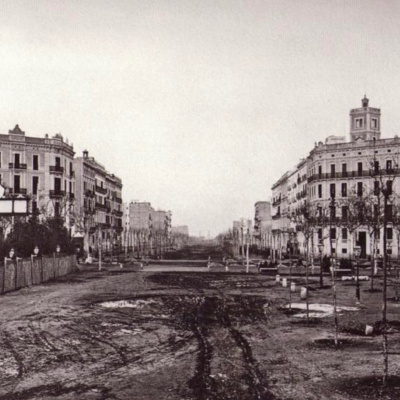HISTORY
The history of Hotel Granvia is closely tied to that of the Eixample
A hotel with history
Constructed in 1870 by master architect Jerónimo Graells, the building that’s home to Hotel Granvia was originally a Bourgeois palace owned by the Serra-Chopitea family.
Hotel Granvia opened in 1935, after a renovation that conserved the palace’s principal elements: the façade, grand staircase, and ballroom. Among the interior spaces that have been carefully preserved over the decades are Gran Vía Hall, Don Bosco Hall, the Chapel, Doña Dorotea’s living quarters, and the entire Gallery with its arcades and columns.
During the 20th century, Hotel Granvia was among Barcelona’s hot spots, hosting famous actors, politicians, and other notables of high society hailing from Catalonia, Spain, and around the world. In addition, the beauty and original details of the hotel walls have made frequent appearances movie shoots, broadcasts, celebrity interviews, and official presentations.



1873
In 1873, the Serra-Chopitea family, the principal shareholders of the company Maquinista Terrestre y Marítima and founding members of the first Bank of Barcelona, established in 1845, moved with their 6 daughters into this palatial mansion on the Gran Via, right in the heart of the Eixample.
In 1882, following the death of her husband, Doña Dorotea de Chopitea redoubled her social commitment, turning her focus to improving the quality of life of the people of Barcelona. She became among the most influential women in the history of Barcelona, earning the honorary title of “Mother of the Poor.”
Doña Dorotea maintained a correspondence with San Juan Bosco and his successor, Miguel Rúa, and played a significant role in the founding of public works of the Salesians in Chile and Barcelona, promoting the construction of temples, schools, hospitals and residences, among them the Temple of the Sacred Heart of Jesus, atop Tibidabo, the Hospital de Sant Joan de Déu, and the Hospital of the Sacred Heart.
She was declared Venerable by Pope John Paul II on June 9th 1983, and her life is currently under consideration for beatification. More recently in 2009, Salesian historian Ramón Alberdi published the biography Dorotea de Chopitea y de Villota (1816-1891). Construir una Barcelona para todos (Building a Barcelona for All), released by Fundación Edebé.



1935
After a major renovation, the palace re-opened as the Hotel Granvia. The reconstruction carefully conserved the façade, the grand staircase leading to the gallery and glass dome, one of the hotel’s ballrooms (Don Bosco Hall), the Chapel, and the living quarters of Doña Dorotea de Chopitea.
It very quickly became a fashionable hotel and was frequently the site of celebrations, dances, and formal functions organized by the Royal Artistic Circle of Barcelona and the Gran Teatro del Liceo. Among its regular guests were renowned actors, politicians, soldiers, and members of Spanish and Catalonian high society.



2012-2013
In the 21st century, further renovations were completed between October 2012 and May 2013. Hotel Granvía now offers 58 unique and stunning rooms, including family rooms and a spectacular JR Suite. A period style room now serves as a Library and Business Center, and leads to a magnificent 500m² terrace-garden to offer a bit of quiet in the bustling heart of the Eixample.
A historical palace for a hotel that makes history.






